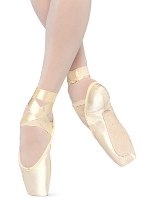for all your ballet needs
Toe Shoes, Pointe Shoes And Pointe Technique
Toe shoes also called pointe shoes, are a very important type of shoe that most people studying ballet will need eventually. These are special ballet shoes that allow the dancer to appear like they are dancing on their tiptoes; this technique is called en pointe. They have a square toe so a dancer can stand on this tip for extended periods of time while they practice or dance the pointe technique. While pointe shoes allow a dancer to stand directly on her toes, in order to achieve a full pointe position, a dancer must use her own strength and technique. Once this full pointe position is achieved, the dancer must continuously contract the muscles of the legs, ankles, feet along with the entire body, to stand full and out of the shoe. Due to this very reason, it is important that a ballet dancer wear the correct shoes. At this stage, the dancer must use soft ballet slippers, before actually wearing the pointe shoes. Moreover, you should be aware that if you try to dance en pointe, when you’re not prepared, or too early, there is a possibility of injury. Normally, you will only see women wearing pointe shoes because they spend more time en pointe than men. If men are dancing women's roles or they have specific dancing they are doing for a specific role, they will also wear them. As an example, a man playing one of the wicked step sisters in the ballet, Cinderella would need to wear a pointe shoe. Most pointe shoes are some shade of pink though they do come in other colors. The main purpose of pointe shoes is to help dancers appear weightless while dancing the ballet. While it is true that being able to balance and dance on the tips of your toes takes years of practice, pointe shoes helps to make it easier. The three main parts of a pointe shoe are – the ribbons, shank and box. Similar to ballet slippers, pointe shoes don’t have a specific left or a right. When you start out wearing them, the shoes are interchangeable, that is you can use it on your left or right foot. However with time, the shoe will take the shape of your feet. Most pointe shoes are made of satin and are generally made by hand. Thus, they can be rather expensive. The block which is the square box in the toe of the shoe, provides balance to the ballet dancer, and enable her to stand on the tips of her toes. You might think that this block, due to its shape and strength, is made of wood, but it is actually made with layers of paper, fabric and glue, sort of like paper mache. A Short History Of The Pointe Shoe The pointe shoe goes all the way back to the Royal Academy of Dance that King Louis XIV created. Women were not allowed to dance ballet until 1681 and at that time, ballet shoes were hard and had heels. As time went on, a famous ballet dancer of the Paris Opera Ballet, Marie Camargo was the first ballet dancer who wore a shoe without a heel so she could do jumps that were more complicated than had been seen on stage at that time. Once the French Revolution came about, the ballet shoe was created without a heal. One of the most famous ballets of the early 18th Century was La Sylphide, which is today one of the oldest surviving of the romance ballets. The famous ballerina Marie Taglioni was the very first woman to wear pointe shoes and she danced en pointe for the entire ballet. What is interesting to note is she did not have the point at tip of her shoe that pointe shoes have now; her shoe was only darned at the end. In those days, dancers had to have very strong ankles and toes in order to dance en pointe. How To Choose a Pointe Shoe Today, a beginning ballerina will not be allowed to use an en pointe shoe until she is at least 9 years old. En pointe is a technique and to do it, one must have very strong ankles and toes. This means that although all dancers will learn how to do it, in reality, only some ballet dancers actually use this technique regularly. When you are picking a shoe, the most important feature is that it must fit well before you do anything else. When these shoes fit properly, they protect the ballet dancer from injuries of the toes, feet or ankles. When you are first learning, it is important to take into consideration your experience in ballet, the strength that you have and the shape of your feet. It is a good idea to ask your ballet instructor the brand that they recommend for your particular pointe shoe needs.
|
www.ballet-pointe.com
|



